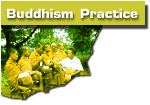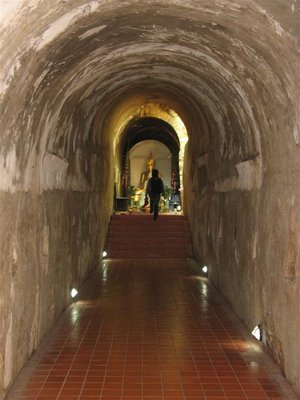 |
BANGKOK
|
||||||||
CENTRAL
|
||||||||||||
NORTHEASTERN
|
||||||||||||||
NORTHERN
|
||||||||||||
SOUTHERN
|
||||
 |
| A GUIDE TO MEDITATION CENTRES IN THAILAND |
| NORTHERN - WAT UMONG |
 |
|
MEANING
OF NAME : |
"Monastery with tunnels" |
OTHER
NAME : |
Suan Buddha Dhamma ("Garden of Buddha's teachings") |
ADDRESS
: |
Tambon Suthep, Amper Muang, Chiang Mai 55000 |
WEBSITE
: |
http://www.watumong.org/ |
DIRECTIONS
: |
Located 3.5 km west of Chiang Mai. Easiest way is by tuk-tuk or bicycle. Or, take a city bus #1 or songtaew west 2.5 km on Suthep Rd. (_not_ the same road to Doi Suthep Temple) to Wang Nam Kan, then follow signs south 1 km to the wat. Chiang Mai is 700 km north of Bangkok and the most important city of the north. Frequent bus, train, and air services connect Chiang Mai with Bangkok and other major centers. |
TELEPHONE
: |
0-5327-7248 (call only from 830 a.m. to 4 p.m.) |
MEDITATION
SYSTEM : |
Anapanasati, similar to teaching at Suan Mokkh. One is free to use one's own meditation techniques. |
TEACHING
METHOD : |
Teachers are available for questions. Talks in English are given every Sunday 3-6 p.m. at the Chinese Pavillion near the pond. A library/museum has many books in English and other foreign languages. |
TEACHERS
: |
Phra Khru Sukhandasila, abbot (Thai; age 56) Phra Santitthito (Santi) (German; age 50) is no longer at Wat Umong; he now takes care of a large forest center in Australia as abbot and residen teacher Wat Buddhadhamma, Ten Mile Hollow, Wisemans Ferry, New South Wales. |
LANGUAGE
: |
One should be able to speak some Thai. Other senior monks, including the abbot, speak a little English. |
DESCRIPTION
: |
Peaceful, wooded grounds of 37.5 rai (15 acres). You can feed the fish, turtles, and ducks in a large pond. "Talking trees" have words of wisdom in Thai and English. The wat is famous for its ancient tunnels and large stupa. Other attractions include a Buddha field of broken sculpture, a fasting Bodhisatva, a Spiritual Theatre of paintings similar to those at Suan Mokkh, reproductions of ancient Buddhist sculpture of India, and a library-museum. This last building offers many books on Buddhism and other philosophies as well as a collection of historic objects and Buddhist art. |
SIZE
: |
monks
45-75 novices about 10 nuns about 8 laypeople about 10 |
DAILY
ROUTINE : |
A bell is rung at 4 a.m. Monks and novices are encouraged (and laypeople welcome) to attend chanting at 430 a.m. and 5 p.m. Monks and novices go on pindabat after morning chanting, then eat together in a wooden sala. Because discipline, practice, and schedule are left up to each person for the most part, self-motivation is especially important. Laypeople on a short visit can follow 5 precepts; longer-term visitors should observe 8 precepts. |
FOOD
: |
Monks eat once or twice a day from food collected on pindabat. Nuns normally cook their own food. Laypeople can also arrange meals at nearby shops or take from monk's leftovers. |
ACCOMMODATIONS
: |
Individual kutis in separate areas for monks/novices,nuns, and laypeople. Kutis, somewhat closely spaced, have screens and electricity; some also have attached Thai-style bathrooms (Asian- and some western-style toilets) and running water. |
WRITE
IN ADVANCE? : |
Yes, write or enquire well in advance. Only a small number of kutis are available for laypeople. |
OTHER
INFORMATION : |
The monastery, one of the oldest in the Chiang Mai area, may date as far back as 1300 A.D. Legend tells that a king built the brick-lined tunnels for a clairvoyant but sometimes eccentric monk named Thera Jan; paintings dated to about 1380 once decorated the walls. You can enter the tunnels to see the small shrines inside (a flashlight is useful). The adjacent stupa was constructed about 1520 over an earlier stupa (1400-1550). The monastery eventually fell into disuse, though Japanese troops were said to garrison here during WW II. Since 1948, the Thai prince Jao Chun Sirorot, now in his 90s, has been active in rebuilding and reestablishing the monastery. In 1949 he invited Buddhadasa Bhikkhu (founder of Suan Mokkh in southern Thailand) to come and live here. Duties kept Buddhadasa Bhikkhu from coming. Instead he sent Ajahn Pannananda and other monks to help set up and run Wat Umong. |
| Select here : |
|
|